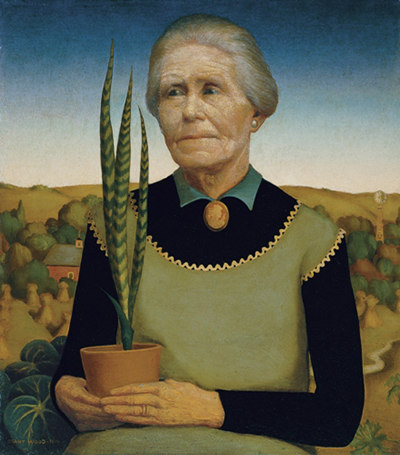Grant Wood painted Woman with Plants in 1929, a year before his break-through work American Gothic. Both were executed in a style known as Midwestern Regionalism, pioneered by Wood and others in the 1930s, and taking American art in a new direction.
Grant Wood's initial training as a designer and craftsman led to a commission for a stained-glass window. To acquire the necessary skill, he left for Germany, where he was impressed by the detail and sharpness of work by sixteenth-century Flemish and German masters, seeing it as reminiscent of his own output as a child. It persuaded him to drop his impressionistic style in favour of a more realistic approach, bringing a fresh honesty to American art. Woman with Plants is a portrait of Wood's mother, seventy-one-year-old Hattie Weaver Wood. Her demeanour is upright, while her experiences as a settler on the American frontier in Iowa are etched into her face. The choice and shape of the plant that she is holding, a sansevieria, continue this theme of rigidity.
The detail of the clothing and jewellery, including the proudly-displayed wedding ring, is typical of the work in Grant Wood's realism style, although some of it harks back to nineteenth-century fashion. The earthy background fits with this depiction of a rural settler in the Midwest, with a directness that was new to American art at this time. Woman with Plants is a sympathetic portrait, with a softer feel than is shown in some of Wood's other pictures. Perhaps this merely reflects the artist's fondness for a parent, but there is also kindness shining through the strength and determination, a necessary part of Hattie's life over the years. Other renditions of Wood's fellow Iowans were more likely to reflect his view that they were narrow-minded, but he still managed to inject some humour into his portrayals.
In fact, most of Grant Wood's paintings are open to interpretation and are ambiguous in meaning, lending themselves to parody by popular culture today - as in The Simpsons and The Muppets TV shows, for example. This has left Wood as both the best-known but also the most controversial of the Regionalists.
Woman with Plants, an oil painting on upsom board, is fittingly owned by Iowa's Cedar Rapids Museum of Art, in the town that was Grant Wood's home from the age of ten. It may not be the most prominent of his paintings, but it captures perfectly the austerity and hardship of the Great Depression. The sympathetic treatment may be due to its personal nature for Grant Wood, who probably mixed his mother's reminiscences with his own personal memories. These subjects are now of historical interest, while the influence of his stylised figures continues today.




